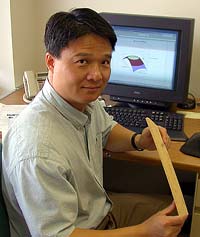Materials Sciences
Materials management deals with the research, development, manufacturing and processing of raw and industrial materials. Key aspects here are biological and medical issues, which play an increasingly important role in this field.
innovations-report offers in-depth articles related to the development and application of materials and the structure and properties of new materials.

U of T research holds promise for optical chip
University of Toronto researchers have developed a hybrid plastic that can produce light at wavelengths used for fibre-optic communication, paving the way for an optical computer chip.
The material, developed by a joint team of engineers and chemists, is a plastic embedded with quantum dots – crystals just five billionths of a metre in size – that convert electrons into photons. The findings hold promise for directly linking high-speed computers with networks that transmit information using

New Bioplastic Reinforced With Natural Fibres
Finland Leads Europe In The Development Of Biodegradable Plastics
VTT, Technical Research Centre of Finland, has made degradable bioplastic more durable due to reinforcement with natural fibres. This biocomposite, which is totally biodegradable, supports sustainable development. The waste costs for products made from this will be small, and in the future consumers will have an enhanced appreciation of biodegradability of materials.
VTT achieved this biocomposite using flax fi

Nanometer-thick clay may yield groundbreaking technology
An ultrathin film containing 1-nanometer thick clay particles has been created for the first time, an accomplishment that may yield new materials and devices for medicine, electronics and engineering, according to Purdue University and Belgian scientists.
Using a method that captures clay particles on a crystal, Purdue and Katholieke Universiteit Leuven research partners were able to produce, see and manipulate a single layer of clay. It would take 70,000 of these layers to equal the thickn

Warped idea: Ways to stop swayed wood may be around the bend
Anyone who buys a swayed plank of wood has to be, well, warped.
But a Texas forestry sciences researcher may have a straight-forward computer model just around the bend, saving millions for wood manufacturers and consumers.
t
“Wood is an old material that has been used in construction for thousands of years,” said Dr. Zhiyong Cai, Texas Agricultural Experiment Station forest products researcher. “Every place in the world uses wood products, but there still are things we don

Prions offer nanotech building tool
The same characteristics that make misfolded proteins known as prions such a pernicious medical threat in neurodegenerative diseases may offer a construction toolkit for manufacturing nanoscale electrical circuits, researchers report this week in the online edition of the Proceedings of the National Academy of Sciences.
Scientists working at Whitehead Institute for Biomedical Research and the University of Chicago write that they have used the durable, self-assembling fibers formed by prions as

NIST, international team develop materials data exchange language
Scientists and engineers trying to share materials property data over the Internet will have an easier time now thanks to a new computer language called MatML–Materials Markup Language–developed by an international group of researchers from the National Institute of Standards and Technology (NIST), industry, government laboratories, universities, standards organizations and professional societies. MatML provides a standard format for managing and exchanging materials property data on the World Wide